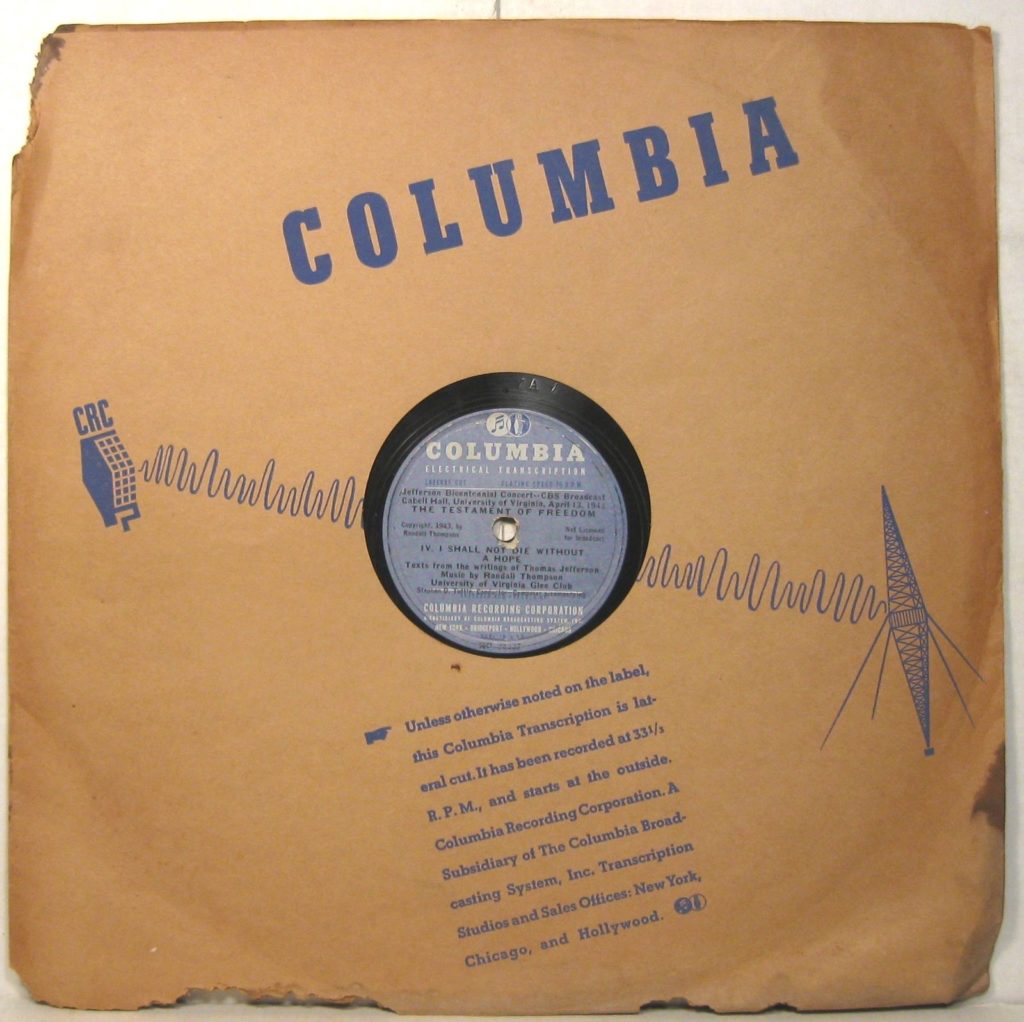
(This is Part 2 of the story of how I got my hands on a copy of the 1943 radio transcription record of the first performance of Randall Thompson’s The Testament of Freedom. Read Part 1 for context about the recording.)
Finding the record on eBay was a heady, exciting moment, tempered by two things: it wasn’t complete, and I wasn’t alone.
I have learned over the years that, while they don’t draw hundreds of bidders, works of history from the University are of enough interest to a small number of collectors that bidding can be competitive. I knew that I could probably win the auction if I paid enough attention—though I’ve lost my fair share of items, I’ve won more than I lost, thanks to a sixteen-year-old paper by one of my grad school professors. I knew that there was at least one other bidder, so I set an alarm for the last day of the auction and waited.
The completeness point was a little more concerning. The available information about the recording indicated that it was a three-record set (not uncommon in the days before 33 1/3 RPM records), but this was only one record. Thankfully, the photo of the label indicated that it was the last movement, easily my favorite of the four. Though Thompson’s setting of Jefferson’s text still plods in places (like any time the word despotism is sung), there is a note of real challenge to the opening words “I shall not die without a hope that light and liberty are on steady advance…”
The day of the auction arrived and I won, despite a flurry of bids earlier in the day. (The odds are good that the other bidder is reading this; sorry and better luck next time!) Now I just had to get the record. And here Fate intervened and made me wait.
The auction ended New Years Eve, one of a series of bitterly cold days with highs in the single digits. The next day the seller contacted me to tell me that he would mail the package a day later, since it was so cold his truck wouldn’t start. I could sympathize, having had to jump-start my own car so that I could take it to the garage to get a new battery. So I waited and watched as the package was shipped—two days before a huge storm that dumped 17 inches of snow on Lexington, Massachusetts.
Perhaps because of the storm, the package took a … circuitous route from New Hampshire to Lexington:

But it finally arrived earlier this week, and to my delight, while the original sleeve was in poor shape (the seller thoughtfully put the record in a new sleeve), the record looked like it was pretty good. Now all I had to do was to listen to it.
Here we had a small snag: my otherwise-wonderful Denon DP-45F turntable has no 78RPM setting. But I was going to digitize the record anyway. So I played it back at 45RPM, and then (as I noted earlier this week) used Amadeus Pro to speed up the playback by 173.3% (78/45). I tried noise reduction but didn’t like what it did to the tone of Thompson’s piano, so I left it alone.
Ultimately, I was pleasantly surprised by the performance. Listening to Thompson’s solo piano introduction to the movement, one is reminded of the historical moment in which the work was written. This was April 1943, more than two years into World War II, and many of the young men singing the work were painfully aware that Jefferson’s words about dying with light and liberty on the advance were not going to be hypothetical for them. The following vocal entrance is appropriately hushed, and the Glee Club declaims Jefferson’s text with clarity and good pitch. The reintroduction of the first-movement “The God who gave us life gave us liberty at the same time” is not strident (as in the 1945 BSO/Harvard Glee Club performance) but nuanced—perhaps because the Virginia men only had to be heard above a piano, not a full orchestra. Only the final chord shows vocal strain in the high tenors.
And here it is! As noted above, the only manipulation was speeding up the playback to restore normal speed, and to join the two halves of the recording into one—which fortunately was pretty straightforward. Enjoy!
